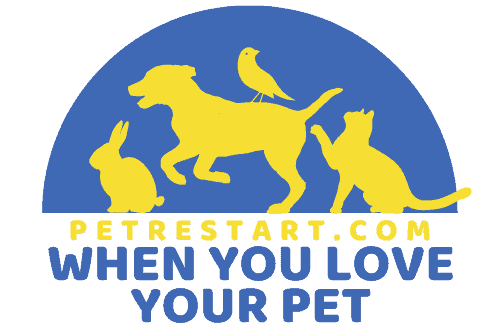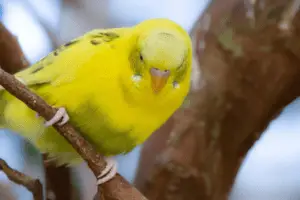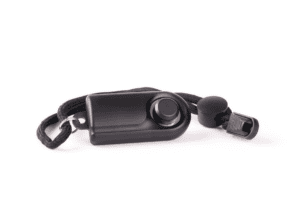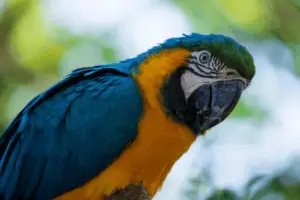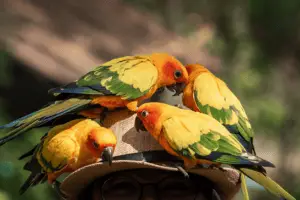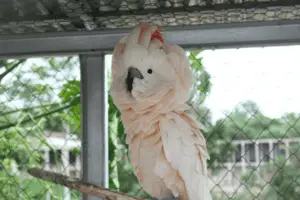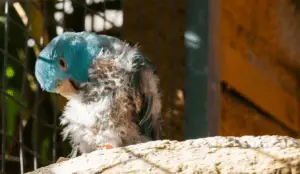Parrots are friendly, intelligent birds known for their fascinating ability to mimic human speech, and as such, it is quite understandable to have a strong desire to pet them. However, petting a parrot is not as straightforward a task, unlike dogs and cats. With their stark differences in anatomy and temperament, knowing how to pet your parrot properly is certainly a necessary skill to have as a parrot owner, and here are the ways to do just that:
5 Tips On Petting A Parrot
- Stay calm, approach slowly.
- Maintain a positive demeanor.
- Respect personal space.
- Observe your parrot’s body language.
- Start with safe places.
Knowing how to navigate your parrot’s petting needs through these five tips should be a great start for you and your parrot to develop quality time with each other. Without further hesitation, let’s get started with point number one.
1: Stay Calm, Approach Slowly
While petting your parrot is quite an exciting experience, it is best to remain calm as you approach them. Primitive instincts dictate that parrots are sensitive to sudden or fast movements. Due to their highly perceptive nature, parrots can sense potential sources of danger and threats, causing them to be quite fearful and anxious, even if that is not your intent.
Make sure you approach your parrot as calmly and reassuringly as possible, allowing them to lower their guard. An easy way to do that is by not making sudden or twitching movements that might induce fear.
In a study entitled “Avian Emotions: Comparative Perspectives on Fear and Frustration,” avians such as parrots are not very apparent when in fear. Still, they do have the capacity to feel such an emotion. (1)
Moreover, when you induce fear in your parrot, they may “avoid when they can, flee if avoidance has not been successful, and defend themselves, usually aggressively, when flight is impossible or difficult.” As such, approaching your parrot calmly and non-hostilely is critical. (2)
2: Maintain A Positive Demeanor
While it may not seem like it, parrots have high levels of emotional intelligence and exhibit signs of these through certain dynamic concepts such as empathy. In an article on the discourse of the view of emotional and cognitive processes that we humans often attribute to “intelligence” by William Carroll, a professor in the School of Philosophy Zhongnan University of Economics and Law, he argues that parrots, like humans, “think and learn” as evident through their highly effective prowess in processing linguistic and auditory information. (3)
In the article, he says, “In both species (animals and birds), not only the usual indications of cognitive sophistication like problem-solving and tool use but also two aspects of intelligence long thought to be exclusively human: episodic memory and theory of mind, the ability to attribute mental states, like intention, desire, and awareness, to yourself and others.” In other words, parrots, and in this context, birds, are not only capable of thinking in conventional cognitive standards but also in terms of emotion– ergo, birds can develop and read emotions and learn and understand from contexts or empathy.
In other words, to present yourself as friendly and non-hostile to your parrot, you, in itself, must be in a friendly and positive demeanor to assert your non-hostility. Exhibiting conventionally kind and positive tones, not only in body actions but also through facial expressions and tone of voice, can signal your parrot that you are a safe and trusted human being– allowing them to easily open up and create a consensus environment for you to pet your parrot.
While in the discourse of avian intelligence, Irene Pepperberg, an associate research professor at Brandeis University, recently discovered in her experiments how parrots are able to learn progressively complex concepts. In fact, she has found out how birds are able to understand the basics of sets and counting. (4)
3: Respect Personal Space
As passionate parrot owners, having a high drive towards attending to your parrot’s needs as soon as possible is a relatable notion. However, while we may feel the responsibility of constantly having to attend to your parrot at all times, most often, putting extra attention on your pet can cause it to become agitated and distant. Simply put, you are not respecting your parrot’s personal space, and it may get quite hard to pet your parrot once you reach this point.
Just like humans, parrots also have a personal space they would appreciate having respected. Especially when dealing with a new parrot, it’s especially important to let the petting experience be a consensual activity. Instead of actively approaching your parrot to pet it, allow it to reach out to you. (5)
Having mutual respect during such an activity signals a certain degree of trust between each other, and a parrot with trust toward its owner fosters a healthy growth environment for your parrot and you. This consensus and mutual respect ensure you and your parrot have positive and enjoyable interactions.
4: Observe Your Parrot’s Body Language
While we learn that our avian friends closely observe our body language, it is also best that we do the same practice to read your parrot’s degree of willingness to do a consensual bonding moment with you. Petting a parrot is an insanely intimate task, requiring them to lower their guard and allow someone to touch delicate parts of their body. As such, being actively aware of your parrot’s condition is critical.
Let’s take, for example, a scenario where your parrot is hungry. Petting your parrots during this time might not be the best idea as they might be agitated and peck you instead. Typically, a parrot that is ready for petting exhibits the following tell-tale signs:
Signs Your Parrot Is Ready For Petting
- in a relaxed state
- calm, bright eyes
- smooth feathers
- uptight
- not ruffled feathers
- not in a defensive posture
By being attentive to your parrot’s state and acting accordingly, you are ensuring that you are petting during the right moments.
5: Start With Safe Places
When petting your parrots, you might notice that some places in their body are better left alone, and some places are comfortable to touch. Because of the variation in the number of nerve endings and the senses triggered by specific regions, parrots like being pet in certain areas more than others.
If you want to get close to your parrots fast, staying safe and avoiding conventionally disliked areas is better. Moreover, it helps develop a stronger owner-pet relationship. Typically, parrots like being touched in these areas of their bodies: (5)
Parrot Petting Preferences
- Parrots typically like being touched in the head, as it highly mimics the preening behavior they experience when with a flock, so make sure to prioritize the head first.
- The same can also be said for the beak, as they prefer it due to its resemblance to preening. Preening is a social gesture between parrots that helps them sanitize themselves and generate stronger bonds through such a ritual. By touching your parrot’s head and beak, in your parrot’s perspective, you are preening them and, thus, bonding with them. (6)
- Parrots like it when you touch their cheeks or behind their ears. Albeit sensitive, with careful touching, parrots love a good caress. These areas can help elevate parrot well-being and demeanor.
- Parrots also like being touched and petting on their back and shoulders, so make sure to touch these areas. However, due to their sensitivity in these areas, be very careful and use gentle and soft hand movements to ensure that your parrot is not overstimulated or afraid.
When getting to know a parrot, these areas are great starters that allow you to bond with them easily, considering of course, the previous points already made in the article.
Summary
Parrots are intelligent and friendly birds with the unique ability to mimic human speech. However, petting a parrot requires special considerations due to their anatomical and temperamental differences from other common pets like dogs and cats.
To properly pet a parrot, staying calm and approaching slowly is important, as it calms down their primitive instincts. Moreover, as parrots are high in emotional intelligence, it is essential to maintain a positive demeanor. Just like humans, respecting their personal space is critical, as they may become agitated and annoyed when their personal space is invaded. Observing their body language can help you get an idea of what they are feeling. You should assess their actions and act accordingly.
Lastly, start with safe places for petting to ensure a fast and surefire way to bond and pet your parrot. Starting with safe areas such as the head, beak, cheeks, and behind the ears allows for a comfortable and bonding experience. These tips will help parrot owners develop a positive and enjoyable relationship with their feathered companions.
Aside from physical touch however, a parrot also has needs such as food, water, shelter, and health care. Make sure that you fulfill these as well, as these are determining factors that will allow your parrot to either open up or avoid you. To get tips on how to clean, feed, and shelter your parrot, read more articles from our blog to find out.
- Papini MR, Penagos-Corzo JC, Pérez-Acosta AM. Avian Emotions: Comparative Perspectives on Fear and Frustration. Front Psychol. 2019 Jan 17;9:2707. doi: 10.3389/fpsyg.2018.02707. PMID: 30705652; PMCID: PMC6344452.
- Gray J. A., McNaughton N. (2000). The neuropsychology of anxiety. Oxford, UK: Oxford University Press.
- Carol, W., Bird Brains and Cross-Species Empathy, Public Discourse, https://www.thepublicdiscourse.com/2016/03/16444/
- Bird Brains: Are Parrots Smarter Than a Human Two-Year-Old?, Scientific American, https://www.scientificamerican.com/article/bird-brains-parrots-smarter/
- Burmeister AK, Drasch K, Rinder M, Prechsl S, Peschel A, Korbel R, Saam NJ. Development and Application of the Owner-Bird Relationship Scale (OBRS) to Assess the Relation of Humans to Their Pet Birds. Front Vet Sci. 2020 Dec 10;7:575221. doi: 10.3389/fvets.2020.575221. PMID: 33363230; PMCID: PMC7758459.
- Bush Sarah E. and Clayton Dale H. 2018Anti-parasite behaviour of birdsPhil. Trans. R. Soc. B3732017019620170196. http://doi.org/10.1098/rstb.2017.0196
